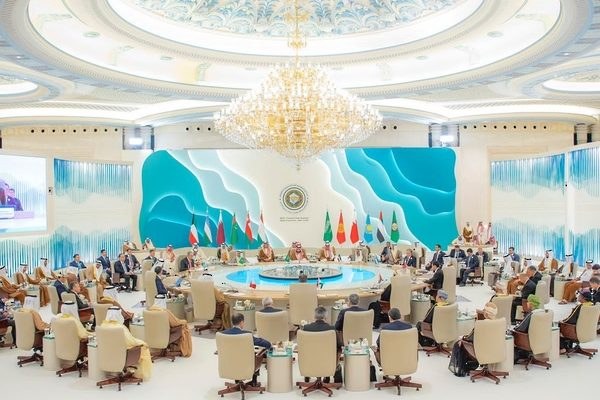
- ARAB NEWS
- 02 May 2024

Trade, transit and energy topped the agenda when foreign ministers from the GCC and Central Asian republics met in Tashkent, Uzbekistan, last week for their second “strategic dialogue”, following an inaugural event in Jeddah last July.
The six Gulf states and Kazakhstan, Kyrgyzstan, Uzbekistan, Tajikistan and Turkmenistan share many of the same challenges and opportunities on the global stage.
Both regions are an important geographical, cultural, and transit crossroads on the Eurasian landmass. Both were the focus of competition between imperial powers in the 18th and 19th centuries and each still deals with the consequences of that today. In the 21st century, both regions strive to pursue independent foreign policies while balancing relations with bigger powers such as the US, Russia, India, China, and the EU.
The joint declaration published after last week’s meeting suggests a determination to improve relations, especially in the policy areas that matter most to both Gulf and Central Asian countries.
For example, the declaration had a strong emphasis on deepening cooperation on energy issues. Both regions are rich in natural resources and are large producers of oil and gas. Considering the volatility of global energy markets in recent years, especially in the aftermath of the COVID-19 pandemic and Russia’s invasion of Ukraine, it makes sense that these two regions want to cooperate on energy issues.
Both regions are an important geographical, cultural, and transit crossroads on the Eurasian landmass.
Luke Coffey
There was also importance placed on improving transport and transit routes between the two regions. While there is potential to increase transit connectivity between the Gulf and Central Asia, doing so in practice will be easier said than done for security and geopolitical reasons. Looking at a map, it is obvious that the most direct route between the Gulf and Central Asia is overland through Iran. But the geopolitical realities in the region mean that this route cannot maximize its full potential. Therefore, policymakers must pursue other creative options to connect the regions.
The most promising transport link that could connect the two regions is the Trans Caspian International Transport Route, which was specifically mentioned in the joint declaration. Commonly referred to as the Middle Corridor, this trade route transits through the South Caucasus, over the Caspian Sea, and into Central Asia connecting the markets of Europe and east Asia. However, there is potential to connect the Gulf region to the project too.
Türkiye has proposed an ambitious project called the Iraq Development Road, also known as the Dry Canal corridor, to link Iraq’s southern Gulf coast to Turkish ports on the Mediterranean by 2038. If the proposed Gulf Railway connecting the six GCC states by rail ever becomes a reality, the possibilities are great. In theory, it would be possible for goods to be transported by rail from the Gulf to markets along the Middle Corridor, via the Dry Canal corridor.
It would be in the interests of Central Asia and the Gulf states to work with regional players to help facilitate genuine transport links and connections across the whole Eurasian land mass. Recently, European Trade Commissioner Valdis Dombrovskis said the EU would commit €10 billion in support of investments to improve transport connectivity in the Middle Corridor. The US and the Organization of Turkic States have also been looking at transport investment opportunities along the route of the Middle Corridor. Being in the center of the Middle Corridor, Azerbaijan also plays an important role as a transit hub. This is why it was particularly noteworthy that Azerbaijan was invited as a “guest of honor” to the meeting in Tashkent.
If the proposed Gulf Railway connecting the six GCC states by rail ever becomes a reality, the possibilities are great.
Luke Coffey
However, one major issue that could stand in the way of energy and transport development is security. There is concern about the growing transnational terrorist groups operating in Afghanistan that can spill over into the broader Central Asia region. Of course, Al-Qaeda and Daesh are a particular concern for the Gulf too. As the humanitarian and governance situation in Afghanistan continues to deteriorate, the security consequences could impact the region and affect transit projects.
So what are the next steps for GCC-Central Asia cooperation? The diplomatic calendar is filling up fast. In the coming months there will be two GCC-Central Asian Investment Forums in Saudi Arabia and Kyrgyzstan. These could generate private sector interest in regional and energy transit projects. Next year, heads of state from the GCC and Central will hold a strategic dialogue in the historically important Silk Road city of Samarkand, and the third ministerial meeting will take place in Kuwait.
All these meetings are important, especially as the Gulf states and Central Asian republics start to deepen and grow their burgeoning relationship. However, meetings and summits go only so far, and practical solutions to the problems facing the countries in the two regions must be pursued in the months ahead. By the time of the heads of state meet in Samarkand next year, there needs to be a concrete road map backed up with funding to make some of the energy and transit projects that have been discussed a reality.
As the world becomes increasingly multipolar, smaller but strategic regions will attract more attention from global powers. The Gulf and Central Asia are two good examples of this. It is in the interest of the countries in these regions to find areas of cooperation, especially when there are overlapping interests. This is the best way to ensure stability, security and economic prosperity.